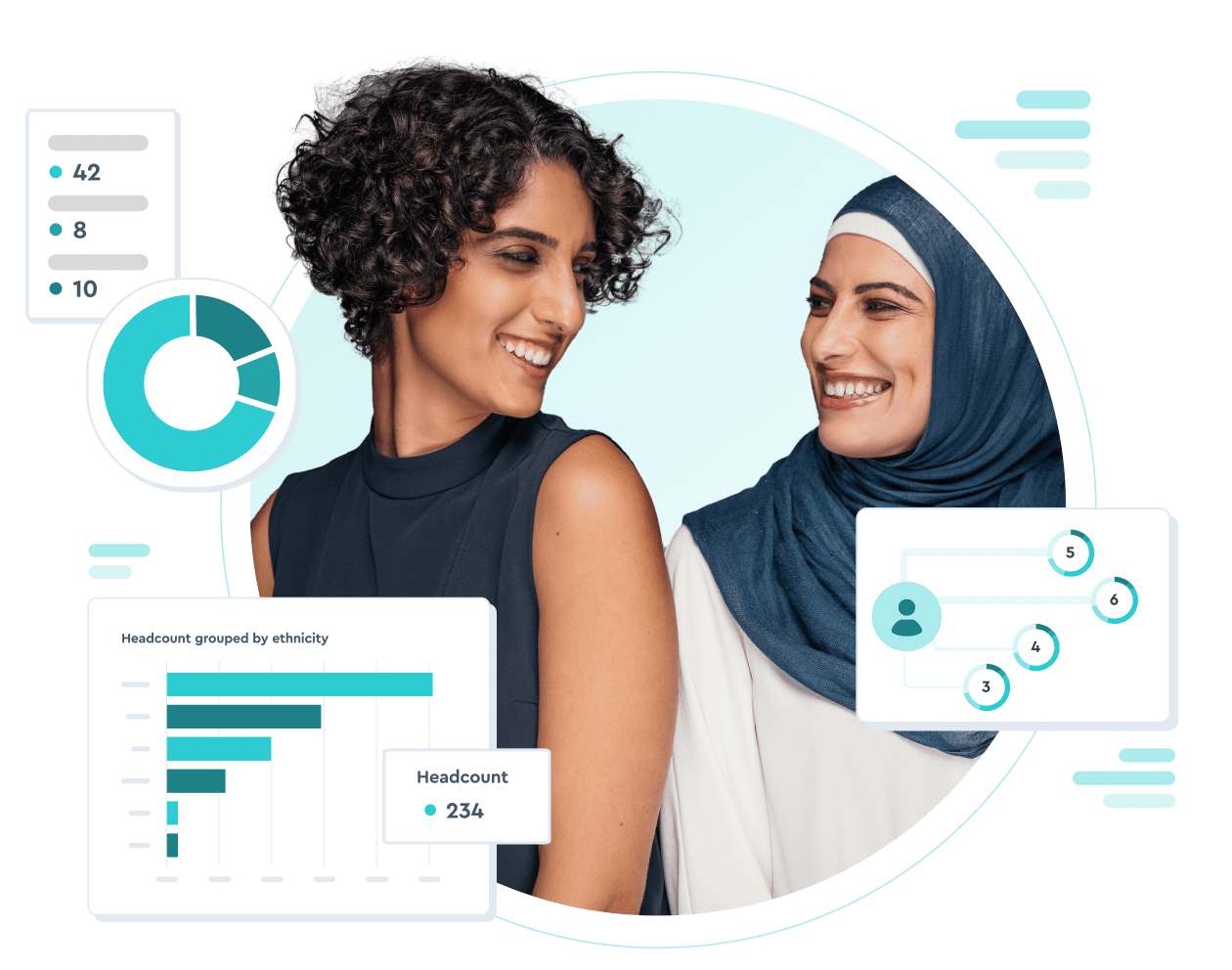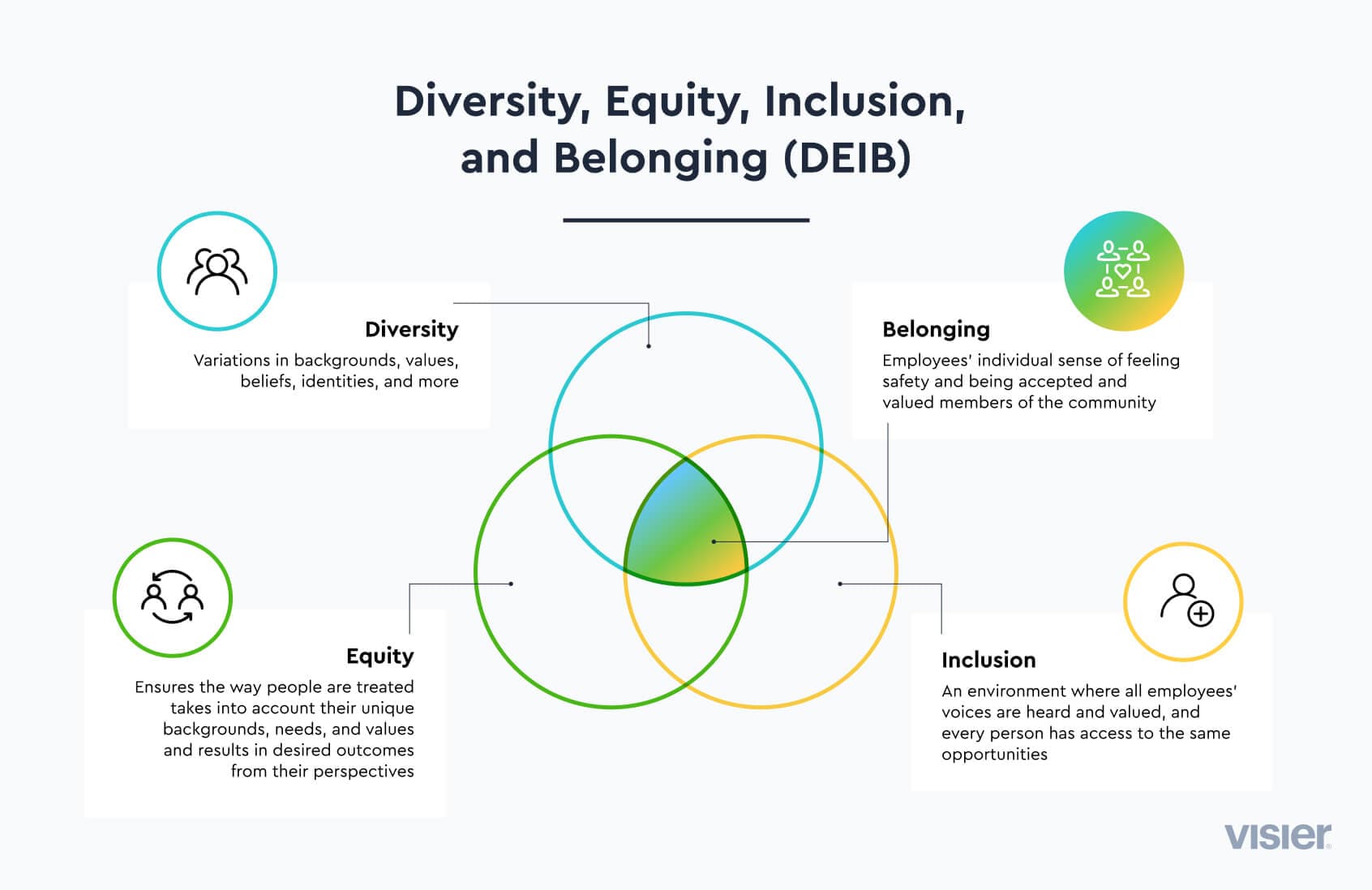DEIB
DEIB: Opportunities and Best Practices for Businesses of All Kinds
By creating a DEIB plan for the workplaces, employers can make sure that everyone feels included and respected. Learn everything you need to know implement effective DEIB efforts here.
Explore diversity planning
Table of contents
What is DEIB?The pros and cons of DEIB effortsThe process for implementing DEIB strategies in the workplaceExamples of DEIB effortsDeliver on DEIBWhat is DEIB?
DEIB stands for Diversity, Equity, Inclusion and Belonging. It’s an ever-evolving philosophy and set of practices designed to create a safe, equitable, and inclusive environment for employees, and others (e.g., customers, vendors, the general public). DEIB is becoming increasingly important in corporate and workplace settings as companies recognize the need to create a culture of acceptance and respect to succeed in today’s global economy.
As part of this effort, employers are creating initiatives such as flexible working environments, diversity education campaigns, and specific hiring practices designed to broaden their leadership teams.
DEIB extends beyond legal requirements like implied or explicit job protections based on race, gender/gender identity, or sexual orientation. These efforts are about promoting a strong sense of belonging in the workspace, and creating an environment where employees feel empowered to bring their whole selves to work without fear of judgment or prejudice.
By embracing DEIB principles, companies can ensure that every person on their team feels valued, respected and has equal opportunities for growth during their tenure at the organization.

The pros and cons of DEIB efforts
DEIB efforts are becoming increasingly important in the workplace. The motivations for these efforts range from improving corporate culture to increasing revenues. And while the benefits of DEIB initiatives may be clear, there also are some potential downfalls that employers should be aware of, and acknowledge.
Pros of DEIB
DEIB initiatives are an increasingly important part of modern businesses for many reasons. DEIB answers the demands for equality and equity to create workplaces that are safe for all their stakeholders.
By implementing DEIB practices and policies, companies can:
Demonstrate a commitment to increasing racial and cultural diversity in their workforces
Eliminate the potential for implicit bias in hiring decisions
Promote fair pay and respect for all employees
Increase employee satisfaction ratings
Create a healthy work environment free from discrimination and harassment
Connect with and engage new customers through effective marketing strategies
Ultimately, these initiatives provide significant benefits to businesses seeking to better respond to the changing needs of society as they focus on attracting and retaining both top talent and customers.
Cons of DEIB
While the benefits of diversity, equity, inclusion, and belonging in business are undeniable, there are also some potential cons associated with DEIB efforts.
Some of the cons of DEIB include:
Challenges and additional workloads required to potentially rework or revise job postings and re-evaluate recruitment tactics
Difficulty in properly training new employees on issues like cultural sensitivity and implicit bias, as well as validating the impact of that training
These difficulties can lead to progress being slower than expected, or a lack of motivation due to staff not being equipped with the right tools. Additionally, many companies today are struggling with how to engage in meaningful conversations about these topics without getting embroiled in conflict—a potentially significant con for any business looking to implement DEIB initiatives.
Finally, DEIB efforts, if not structured or executed properly, can alienate certain groups of employees. Saying the wrong thing can easily offend people, of course. But, more importantly, DEIB efforts can make employees who aren’t part of traditionally marginalized groups—think white, straight, middle-aged men—suddenly feel marginalized.
At the same time, the focus on employees’ immutable characteristics (race, gender, sexual orientation, etc.) can make employees feel like they’re being defined purely or largely because of factors they can’t change. Instead of being the star accounting wizard, someone might feel like they’re being seen as the “female African-American accounting wizard.”
Despite these potential downfalls, though, most forward-thinking organizations today recognize the value that DEIB can bring to their workforce, and their bottom line.

The process for implementing DEIB strategies in the workplace
Implementing DEIB strategies in the workplace can be a complex process that requires careful consideration and an in-depth knowledge of organizational change.
A successful Diversity, Equity, Inclusion, and Belonging strategy involves:
Identifying problematic areas, or gaps, related to DEIB
Developing clear and measurable goals
Creating a DEI statement
Gathering feedback from staff and other key stakeholders
Investing in training and development to educate employees on cultural competencies
Fostering an environment of open communication
To ensure the most effective implementation of a DEIB strategy, it’s important to increase HR support. This can be accomplished by establishing dedicated roles or teams responsible for reviewing hiring and other employment practices, and providing resources to those teams to foster a sense of inclusion among all staff members.
Successful DEIB efforts are viewed as a process, rather than an event, with ongoing and open conversations and transparency prerequisites for establishing a healthy culture to support DEIB.
With the right plan in place, organizations can create a culture where everyone feels welcomed and valued, which leads to engagement, productivity and retention.
Examples of DEIB efforts
DEIB efforts have gained considerable attention in recent years. As a result, many companies have created initiatives to ensure their commitment to increasing diversity in the workplace and fostering an environment of inclusion and belonging.
Some examples of DEIB activities include:
Conducting a baseline DEIB climate assessment
Forming employee resource groups
Hiring third party diversity consultants
Implementing cultural training programs
Revising recruitment, hiring, promotion, and other employment procedures to ensure equity and inclusivity
Many employers also are hosting events that promote cultural awareness and dedicating significant resources to recruiting from underrepresented groups.
Organizations should consider both the pros and cons of DEIB before implementing any strategies. There is no one-size-fits-all solution when it comes to DEIB, so organizations must carefully tailor their efforts to their own specific needs and culture. With a clear process and understanding of the potential pitfalls, organizations can create meaningful change that leads to a more inclusive workplace for all.

Deliver on DEIB
Data and insights are critical to fulfilling your DEIB commitments. People analytics and advanced business intelligence tools offer organizations of all sizes the ability to set, measure, and achieve, and grow their DEIB efforts. Strategic compensation strategies allow organizations to easily look at comparisons and analyses of employee compensation across job functions, geographic regions, seniority levels, demographics, providing greater transparency into how compensation is allocated to different groups of employees and to identify any disparities that need to be addressed.
Part of maintaining a diverse workplace is retaining the diversity a company already has. Existing diverse employees may represent an opportunity to encourage other diverse workers to join the organization and can also serve as mentors to more junior staff.
People leaders are essential to the execution of any people strategy, and DEIB is no different. Most workers have far more regular contact with their supervisors than HR. Provide diversity, equity, and inclusion training at your organization, and offer an additional course for people leaders.

![Diversity, Equity, and Inclusion: What it Means, and Why it’s Important [CARD IMAGE ASSET]](https://images.ctfassets.net/lbgy40h4xfb7/7JlEch8sfT82UqQmpljBEM/2200267b1614b0dcdbfe3233fa8a1c2c/dei-blog.jpg?w=1200&h=700&fl=progressive&q=100&fm=jpg)
![How to Implement Diversity, Equity, and Inclusion Training at Your Organization [CARD IMAGE ASSET]](https://images.ctfassets.net/lbgy40h4xfb7/1CQwWOaeZt2YV2qt9XswvP/cb080ff38fbb7059b75cc9de50b9fa61/dei-training-blog.jpg?w=1200&h=700&fl=progressive&q=100&fm=jpg)
![How to Write a Diversity, Equity, and Inclusion (DEI) Statement [CARD IMAGE ASSET]](https://images.ctfassets.net/lbgy40h4xfb7/7cqyI2xFSJgXFy44eivL3m/51056f41fc8c75421f5039ab46f67330/dei-statement-blog.jpg?w=1200&h=700&fl=progressive&q=100&fm=jpg)